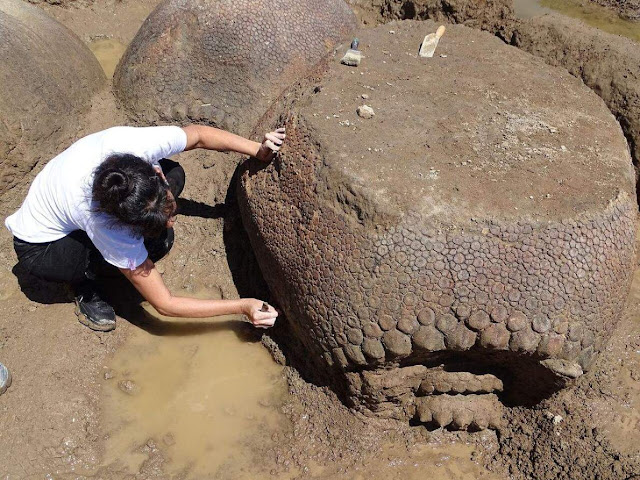
In recent years, Argentina has become a treasure trove for paleontologists, with a wealth of fossils discovered in the country’s vast expanses. One of the latest discoveries made headlines worldwide, as a farmer stumbled upon the shells of four ancient armadillos called Glyptodonts, the size of cars.

The largest of the four shells is about the size of a Volkswagen Beetle, making it one of the most impressive fossil discoveries of recent years. The discovery was made in a dried-out riverbed near Buenos Aires, Argentina, and has been investigated by the Institute of Archaeological and Palaeontological Investigations of the Pampa Quaternary.

The shells were spotted by Juan de Dios Sota, who was out grazing his cows when he noticed the shapes of the shells. When scientists arrived at the site, they were amazed to discover that there were four Glyptodont shells, two adults and two young animals, in the same location.

These Glyptodonts were like gigantic armadillos that developed about 20 million years ago and were found all across Latin America. Much like their descendants, they possessed a large, tough shell that protected them from various dangers. However, unlike their descendants, they could grow up to 10 feet long, reaching the size of a car.

Despite being the size of cars, they were gentle giants and were completely herbivorous. Unfortunately, it is thought that they became extinct at the start of the last ice age. Their shells were made of bone and could weigh as much as 1,100 pounds (500 kg), which is about 20 percent of their overall body weight.

These fossils are incredibly rare, with near-complete shells not found very often. The discovery of four Glyptodont shells in the same location is highly unusual and significant. Scientists from the Institute will now spend the next week digging out the shells to find out as much as possible about the creatures.

Tests will be performed to determine how old they are, what sex they were, and how they potentially died. At this stage, it is believed that they are roughly 20,000 years old.


While it is a shame that these incredible creatures no longer exist, their fossils provide a glimpse into the past and allow us to learn more about the animals that roamed the earth millions of years ago. The discovery of these Glyptodont shells is just one of many exciting finds that will continue to captivate scientists and the public alike.

Leave a Reply